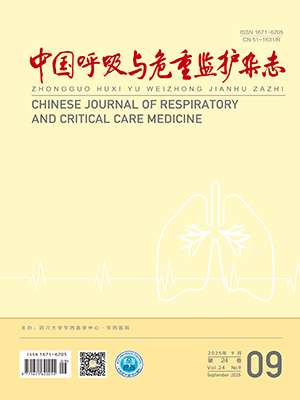| 1. |
Fang LW, Gao P, Bao HL, et al. Chronic obstructive pulmonary disease in China: a nationwide prevalence study. Lancet Respir Med, 2018, 6(6): 421-430.
|
| 2. |
Wang C, Xu JY, Yang L, et al. Prevalence and risk factors of chronic obstructive pulmonary disease in China (the China Pulmonary Health study): a national cross-sectional study. Lancet, 2018, 391(10131): 1706-1717.
|
| 3. |
Zhou MG, Wang HD, Zeng XY, et al. Mortality, morbidity, and risk factors in China and its provinces, 1990-2017: a systematic analysis for the Global Burden of Disease Study 2017. Lancet, 2019, 394(10204): 1145-1158.
|
| 4. |
中华医学会呼吸病学分会慢性阻塞性肺疾病学组, 中国医师协会呼吸医师分会慢性阻塞性肺疾病工作委员会. 慢性阻塞性肺疾病诊治指南(2021 年修订版). 中华结核和呼吸杂志, 2021, 44(3): 170-205.
|
| 5. |
From the Global Strategy for the Diagnosis, Management and Prevention of COPD, Global Initiative for Chronic Obstructive Lung Disease (GOLD). 2011. Available at: http://www.goldcopd.org/.
|
| 6. |
From the Global Strategy for the Diagnosis, Management and Prevention of COPD, Global Initiative for Chronic Obstructive Lung Disease (GOLD). 2021. Available at: http://www.goldcopd.org/.
|
| 7. |
梁振宇, 王凤燕, 陈荣昌. 慢性阻塞性肺疾病诊治指南(2021 年修订版)的重要更新解读及展望. 国际呼吸杂志, 2021, 41(19): 1457-1461.
|
| 8. |
谭漫琳, 简文星, 梁秋菊, 等. 不同评价系统对慢阻肺患者病情及治疗疗效的评估价值. 南方医科大学学报, 2021, 41(7): 1119-1124.
|
| 9. |
Jones PW. Health status and the spiral of decline. COPD, 2009, 6(1): 59-63.
|
| 10. |
李海宁, 马千里, 王长征, 等. 影响支气管哮喘患者合并焦虑/抑郁情绪的多因素分析. 国际呼吸杂志, 2017, 37(23): 1761-1765.
|
| 11. |
万敏, 唐小婷, 张巧, 等. 哮喘–慢阻肺重叠综合征患者 240 例临床特征分析. 第三军医大学学报, 2015, 37(21): 2181-2185.
|
| 12. |
Jones PW, Quirk FH, Baveystock CM. The St George's Respiratory Questionnaire. Respir Med, 1991, 85 Suppl B: 25-31; discussion 33-37.
|
| 13. |
Jones PW, Quirk FH, Baveystock CM, et al. A self-complete measure of health status for chronic airflow limitation. The St. George's Respiratory Questionnaire. Am Rev Respir Dis, 1992, 145(6): 1321-1327.
|
| 14. |
Domingo-Salvany A, Lamarca R, Ferrer M, et al. Health-related quality of life and mortality in male patients with chronic obstructive pulmonary disease. Am J Respir Crit Care Med, 2002, 166(5): 680-685.
|
| 15. |
孙甜, 李晓云, 彭雅婷, 等. 慢性阻塞性肺疾病晨间症状与其他临床特征的关系及相关因素分析. 中国呼吸与危重监护杂志, 2021, 20(6): 381-387.
|
| 16. |
殷晓娜, 杨万春. CAT 和 mMRC 评分系统在慢性阻塞性肺疾病病情评估中的应用价值分析. 中国现代医药杂志, 2021, 23(3): 19-22.
|
| 17. |
周丽娟, 温贤秀, 吕琴, 等. 使用机器学习建立慢性阻塞性肺疾病患者重度气流受限风险预警模型研究. 中国全科医学, 2022, 25(2): 217-226.
|
| 18. |
de la Loge C, Tugaut B, Fofana F, et al. Relationship between FEV1 and patient-reported outcomes changes: results of a meta-analysis of randomized trials in stable COPD. Chronic Obstr Pulm Dis, 2016, 3(2): 519-538.
|
| 19. |
文富强, 陈磊. 中国慢性阻塞性肺疾病诊疗的现存问题与思考. 中华医学杂志, 2020, 100(2): 81-84.
|
| 20. |
李正欢, 张晓云, 陈杨, 等. 2020年慢性阻塞性肺疾病全球倡议《COPD诊断、治疗与预防全球策略》指南解读(一)—稳定期药物管理. 中国全科医学, 2021, 24(8): 923-929.
|




